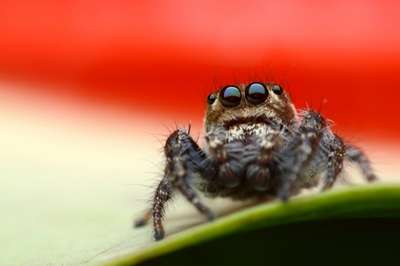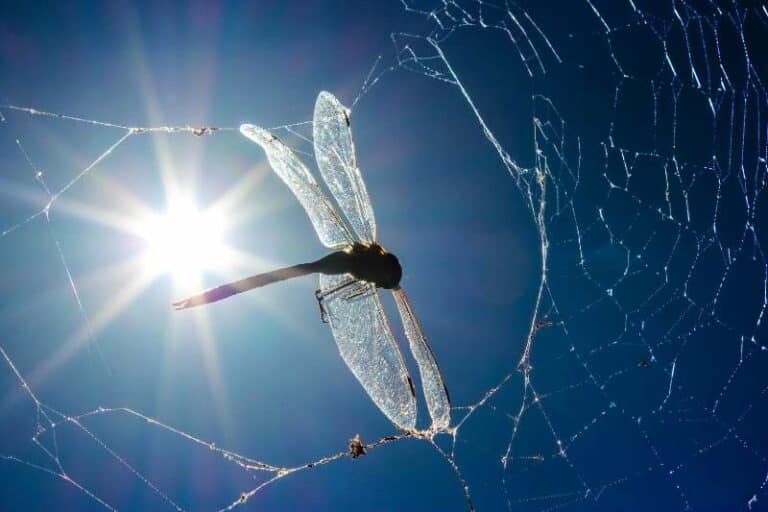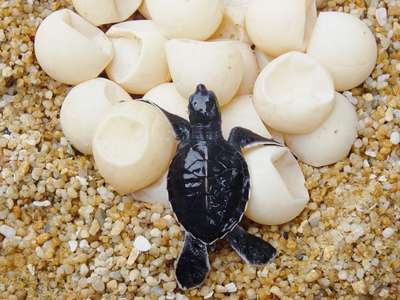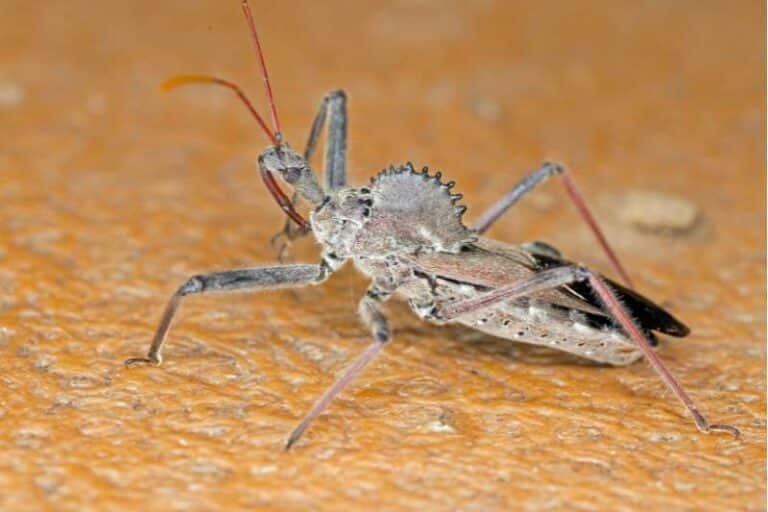The Eastern Tailed Blue butterfly (Everes comyntas) is small, gorgeous, abundant throughout North Carolina, and amazingly easy to overlook. This diminutive gossamer wing butterfly flies low to the ground, has a wingspan of only about an inch, and often keeps the beautiful, iridescent blue of its wings hidden by folding them tightly over its back when perched.
But this tiny species is well worth the effort to observe in the wild, especially as it appears earlier in the spring, and survives later in the fall, than some of the other larger, flashier North Carolina butterfly species.
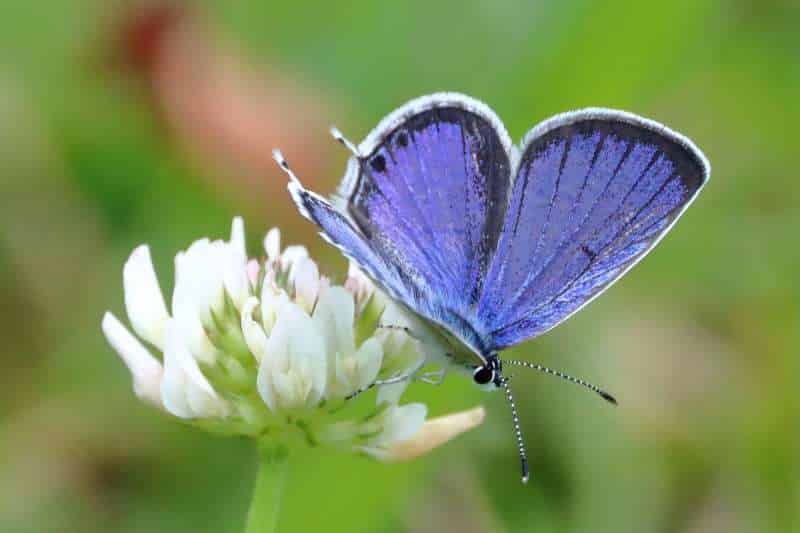
Fun Facts About Eastern Tailed Blue Butterflies To Wow Your Friends
- The Eastern Tailed Blue butterfly (Everes comyntas) is the only species within the gossamer wing family with a tail trailing off its hindwing.
- Tails may be short or missing on older individuals as they are fragile and easily rubbed off or torn due to normal wear and tear or during predator attacks.
- Eastern Tailed Blue butterflies have bright orange marks on their hindwings, right at the base of their tails, that contrast sharply with the silvery-gray of their underwings.
- Some believe that the combined tail and marks is an anti-predator defense, in that it mimics the insects’ head and antennae and tempts the predator into attacking the wrong end of the butterfly.
- Eastern Tailed Blue butterflies (Everes comyntas) require grassland habitats. They are a “disturbance-avoider” species, which means they are found in the highest number at sites that have been undisturbed by human activities (Hogsden and Hutchinson, 2004).
How Are Eastern Tailed Blue Butterflies Classified?
| Kingdom | Animalia |
| Phylum | Arthropoda |
| Class | Insecta |
| Order | Lepidoptera |
| Family | Lycaenidae (“gossamer wings”, sub-family Polyommatinae, “blues”) |
| Genus species | Everes comyntas |
How Do I Know I’m Looking at an Eastern Tailed Blue Butterfly?
Appearance of Eastern Tailed Blue Butterfly Eggs
The eggs of Eastern Tailed Blue butterflies are pale green; females lay them one at a time on flowers, buds, and leaves of pea plants in family Fabaceae.
Appearance of Eastern Tailed Blue Butterfly Caterpillars / Larvae
Eastern Tailed Blue caterpillars grow to about 0.5 inches (1.25mm). Their color varies widely and can be green, yellow, pink, rose, or purple-brown (Wagner, 2005), but are usually dark green. A thin reddish-brown center stripe runs down the length of their backs and a pale white and red stripe runs down their sides. The caterpillars’ bodies are covered in short hairs which are usually white but sometimes black (Wagner, 2005).
Chrysalids of Eastern Tailed Blue butterflies are buff-colored (Pyle, 1981).
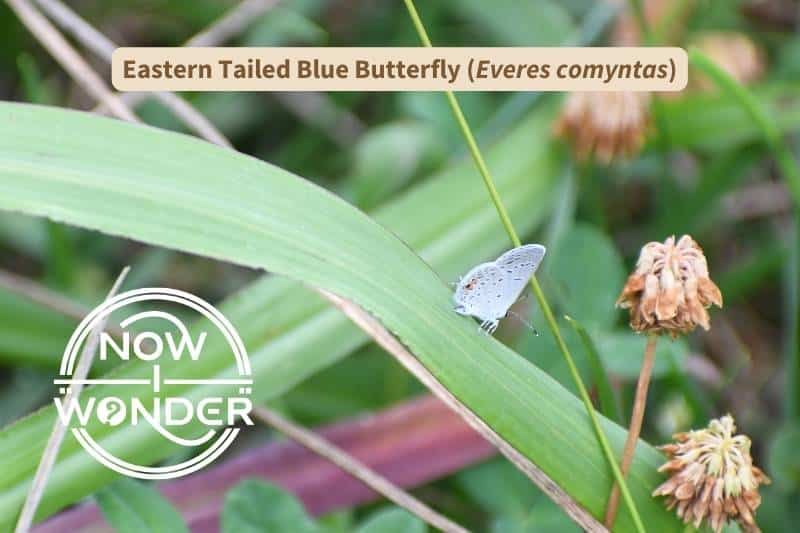
Appearance of Adult Eastern Tailed Blue Butterflies
Adult Eastern Tailed Blue butterflies grow to about 1.125 inches (29mm). They have furry bodies, which vary in color depending on sex. The fur of male Tailed Blues is bright blue above and white below, while the fur on females is brown above and white below. Both sexes have black eyes and black and white-striped clubbed antennae.
The sexual dimorphism between male and female Eastern Tailed Blues seen in the body fur carries over into the appearance of the upper surface of their wings. Males are much more brightly colored than females. Their dorsal wing surfaces are brilliant, iridescent blue overall; their wings are bordered in black, the edges are traced in a fine white line and are surrounded by a thick fringe of short white hairs.
Females are mainly brown on top, with blue shading at certain light angles. Spring females have more blue at their wing bases than adult females seen later in the season.
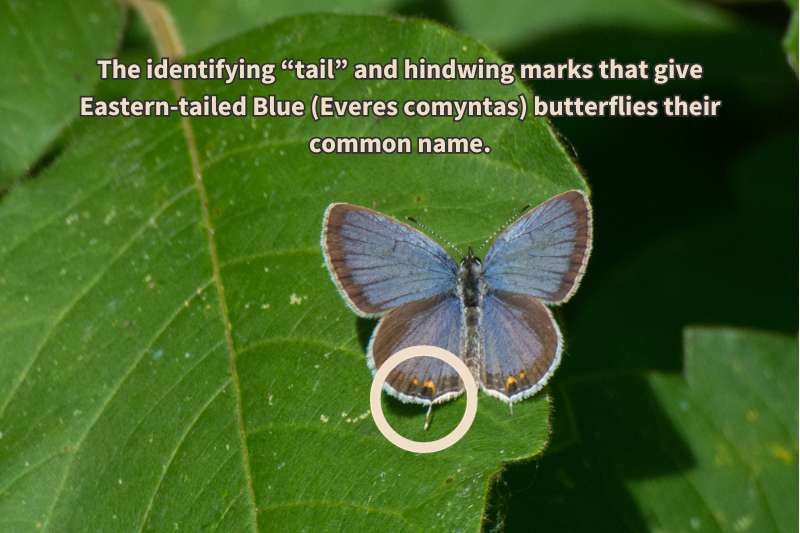
The underside, or ventral, wing surface of these butterflies is pale silvery-white with curved rows of distinct black spots and two side-by-side orange marks on the hind wing margins. One of the orange marks is at the base of a fine, hairlike tail trailing from the edge of each hindwing. Eastern Tailed Blues (and its close relative the Western-tailed Blue, which is not found in North Carolina) are the only “blue” butterflies that have this threadlike tail.
The best way to identify these butterflies in the field is by the color pattern on the ventral wing surface. Eastern Tailed Blues close their wings over their backs when perched so really the only time you can see the bright blue or brown-blue of their upper wings is in flight or when they are basking in the sun.
While this species is the only member of the gossamer wing family of butterflies to have a tail on their hind-wings, this isn’t the most reliable field mark. Adults often lose their thin and fragile tails due to normal wear and tear caused by flying amongst vegetation and sometimes as a result of attack by a predator.
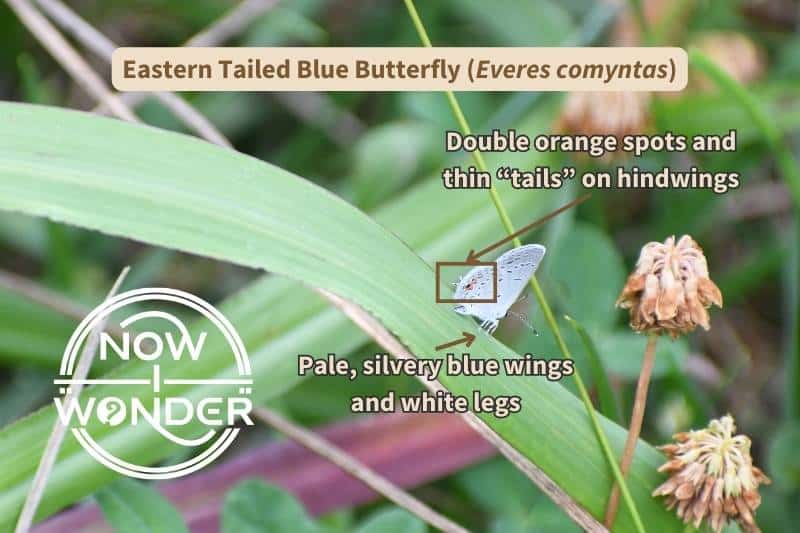
Some believe that the combined wing “tails” and bright, high-contract orange marks is an anti-predator defense, in that it mimics the insect’s head and antennae and tempts predators into attacking the wrong end of the butterfly.
I personally am unsure how effective an anti-predator strategy this actually is.
The hindwing spots and tail do attract attention, but Eastern Tailed Blue butterflies also have large, black eyes that are very obvious against their pale body fur. It seems unlikely to me that a predator who is close enough to an Eastern Tailed Blue to attack would be distracted from the large, obvious, edible head and body of the insect by relatively tiny orange, inedible hindwing spot.
Also, even when intact, the threadlike tails are very short compared to the butterflies’ actual antennae. Again, it seems unlikely to me that a predator would be so entranced by the minimal swaying of the hindwing tails that it fails to notice the rapid waving of much longer and thicker black and white striped antennae at the edible end of the insect.
However, this is not to say that this hypothesis is wrong; only that it doesn’t make intuitive sense to me.
When Can I Find Eastern Tailed Blue Butterflies in North Carolina?
Eastern Tailed Blue butterflies (Everes comyntas) have three (3) broods per year in North Carolina, starting in February and extending through to November (Opler and Malikul, 1992). Females lay their eggs in flower buds and stems of host plants while the caterpillars overwinter inside bean and pea pods (Pyle, 1981).
Where Should I Look to Find Eastern Tailed Blue Butterflies?
Adult Eastern Tailed Blue butterflies are found in open, sunny areas with low-growing vegetation, like meadows, fields, and overgrown lawns. They are also common in disturbed areas like power line cuts and along railroads.
These butterflies like to fly low, almost hugging the ground. They can be hard to see when perched because of their small size and relatively inconspicuous ventral wing surface coloration.
The best way to spot these butterflies is to wait motionless in a likely habitat, like a flowery meadow, and watch carefully for flitting motion inches above the tops of the plants. When you see one, don’t get distracted; follow it down into the vegetation with your eyes until it lands and you can watch it unfurl its long, thin proboscis and feed.
Male Eastern Tailed Blue butterflies also like to gather around damp soil to drink salts and other minerals – a behavior known as “puddling” – so a lucky observer can sometimes see many individuals at one time, especially in spring.
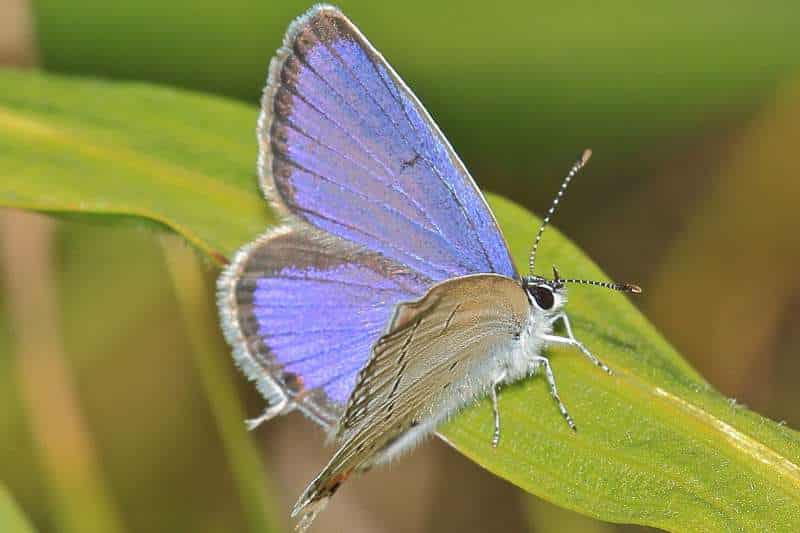
What Do Eastern Tailed Blue Butterflies Eat?
Eastern Tailed Blue Butterfly Larval Food Plants
Eastern Tailed Blue caterpillars eat plants in the legume and pea family, such as clovers (Trifolium), beans (Phaseolus), wild peas (Lathyrus), lupine, vetch, and trefoils (Desmodium) (Bartlett-Wright, 1993) (Pyle, 1981). They eat all parts of the plant, including flowers and seeds as well as new leaves.
Adult Eastern Tailed Blue Butterfly Food
Adult Eastern Tailed Blue butterflies feed on nectar from a wide variety of flowering plants, especially white sweet clover, dogbane, butterfly milkweed, and daisy fleabane.
References
Bartlett–Wright, Amy. 1993. Peterson First Field Guides: Caterpillars. Boston, MA: Houghton Mifflin Company.
Hogsden, Kristy L. and T. C. Hutchinson. 2004. “Butterfly Assemblages Along a Human Disturbance Gradient in Ontario, Canada.” Canadian Journal of Zoology 82 (5) (05): 739-748.
Opler, Paul A. and Malikul, Vichai. 1992. Peterson Field Guides: Eastern Butterflies. New York, NY: Houghton Mifflin Company.
Pyle, Robert Michael. 1981. National Audubon Society Field Guides to Butterflies: North America. New York, NY: Alfred A. Knopf.
Wagner, David L. 2005. Princeton Field Guides: Caterpillars of Eastern North America. Princeton, NJ: Princeton University Press.


